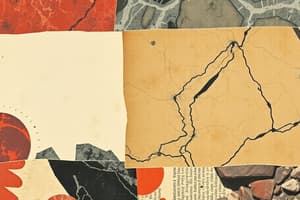Podcast
Questions and Answers
What primary characteristic distinguishes igneous rocks from sedimentary rocks?
What primary characteristic distinguishes igneous rocks from sedimentary rocks?
- Igneous rocks are the result of metamorphic processes under high pressure.
- Igneous rocks are produced by crystallization from a liquid. (correct)
- Igneous rocks always contain visible fossils, unlike sedimentary rocks.
- Igneous rocks are formed from particles deposited in layers by rivers and oceans.
Why is understanding soil composition important in site planning?
Why is understanding soil composition important in site planning?
- It primarily determines the aesthetic value of the site.
- It allows for predicting bearing capacity, internal drainage, erodibility, and slope stability, which affects land use. (correct)
- It mainly affects the types of vegetation that can be grown.
- It dictates the amount of rainfall the site will receive.
How does the texture of soil primarily influence its suitability for different uses in site design?
How does the texture of soil primarily influence its suitability for different uses in site design?
- Texture determines the soil's color and aesthetic appeal.
- Texture describes the composite sizes of particles in a soil sample, affecting water movement and structural stability. (correct)
- Texture indicates the presence of organic matter.
- Texture affects the soil's ability to retain nutrients necessary for plant growth.
Which of the following describes the ecological role related to wildlife in site analysis?
Which of the following describes the ecological role related to wildlife in site analysis?
How do contour lines on a topographic map help in understanding geomorphology?
How do contour lines on a topographic map help in understanding geomorphology?
What is the main factor contributing to poor drainage in soil?
What is the main factor contributing to poor drainage in soil?
Which soil composition, when present in high volume, is most likely to provide the greatest structural stability for building foundations?
Which soil composition, when present in high volume, is most likely to provide the greatest structural stability for building foundations?
Which of the following best describes the use for slate in construction and design?
Which of the following best describes the use for slate in construction and design?
What does 'percolation' refer to in the context of soil drainage?
What does 'percolation' refer to in the context of soil drainage?
If a soil sample is composed of 45% sand, 30% silt, and 25% clay, into what textural class would it be categorized?
If a soil sample is composed of 45% sand, 30% silt, and 25% clay, into what textural class would it be categorized?
How are sedimentary rocks formed?
How are sedimentary rocks formed?
What is the primary focus when 'reading' a map in the context of site analysis?
What is the primary focus when 'reading' a map in the context of site analysis?
Why is it important to consider climate during site analysis?
Why is it important to consider climate during site analysis?
How does the understanding of soil composition and texture relate to erosion control in site planning?
How does the understanding of soil composition and texture relate to erosion control in site planning?
What process defines how metamorphic rocks are formed?
What process defines how metamorphic rocks are formed?
What does the term 'angle of repose' refer to in the context of topography and slopes?
What does the term 'angle of repose' refer to in the context of topography and slopes?
In site design, what is the importance of evaluating the local geology of an area?
In site design, what is the importance of evaluating the local geology of an area?
Which of the following best describes the relationship between soil composition and water content?
Which of the following best describes the relationship between soil composition and water content?
Which of the following is the correct definition of ecology?
Which of the following is the correct definition of ecology?
What is the formula for Class Loam soil?
What is the formula for Class Loam soil?
Flashcards
What is Ecology?
What is Ecology?
The branch of biology studying organism relations to each other and their surroundings.
Site Analysis (Natural Factors)
Site Analysis (Natural Factors)
Study of a site's natural aspects: geology, geomorphology, hydrology, vegetation, wildlife, and climate.
Igneous Rocks
Igneous Rocks
Rocks formed from the cooling and solidification of magma or lava.
Sedimentary Rocks
Sedimentary Rocks
Signup and view all the flashcards
Metamorphic Rocks
Metamorphic Rocks
Signup and view all the flashcards
Geomorphology
Geomorphology
Signup and view all the flashcards
Soil composition Importance
Soil composition Importance
Signup and view all the flashcards
Soil Surveys: Purpose
Soil Surveys: Purpose
Signup and view all the flashcards
Soil properties used in site design
Soil properties used in site design
Signup and view all the flashcards
Soil Composition
Soil Composition
Signup and view all the flashcards
Bearing Capacity
Bearing Capacity
Signup and view all the flashcards
Poor Drainage
Poor Drainage
Signup and view all the flashcards
Good Drainage
Good Drainage
Signup and view all the flashcards
Infiltration
Infiltration
Signup and view all the flashcards
Permeability
Permeability
Signup and view all the flashcards
Percolation
Percolation
Signup and view all the flashcards
Soil Texture
Soil Texture
Signup and view all the flashcards
Slope Analysis Requirement
Slope Analysis Requirement
Signup and view all the flashcards
Angle of Repose
Angle of Repose
Signup and view all the flashcards
Map Reading
Map Reading
Signup and view all the flashcards
Signup and view all the flashcards
Signup and view all the flashcards
Signup and view all the flashcards
Signup and view all the flashcards
Signup and view all the flashcards
Signup and view all the flashcards
Signup and view all the flashcards
Study Notes
- Site analysis involves assessing a site based on various ecological considerations
- Site analysis studies natural factors like geology, geomorphology, hydrology, vegetation, wildlife, and climate
Ecology
- Ecology is the biological study of the relationships between organisms and their surroundings
- Ecology is also a political movement focused on environmental protection, specifically against pollution
Geology
- Geology is a natural factor in site analysis
- Geology studies the origin, composition, structure, and history of the Earth
Igneous Rocks
- Igneous rocks are formed through the crystallization of liquid rock
- Andesite can be used as aggregate or fill in construction and roads
- Obsidian was historically used for tools like knives and arrowheads
- Basalt is commonly crushed for aggregate in construction projects
- Granite is used in buildings, bridges, paving, monuments, countertops, tile floors, and stair treads
- Pumice serves as aggregate in lightweight concrete, landscaping, and as an abrasive in industrial and consumer products
- Tuff, easy to work with, has been used as a building material and for statues since ancient times
Sedimentary Rocks
- Sedimentary rocks form when igneous rocks weather and erode into particles
- These particles are then transported by erosional processes
- Finally, the particles are deposited in layers within rivers and oceans
- Uses for Bituminous include road and roof construction, industrial purposes, carpet tiles, paint, and waterproofing
- Chert can be used as decorative aggregates for buildings and gardens and as material for cutting tools
- Flint can be used for Interior: decorative aggregates, home, interior decoration
- Flint can be used for Exterior: As bldg. stone, as facing stone, garden decoration, office buildings, paving stone
Metamorphosed Rocks
- Metamorphosed rocks form from sedimentary rocks
- Sedimentary rocks are pushed to deeper levels within the Earth
- This causes the sedimentary rocks to transform due to changes in pressure and temperature
- State is often used for roofing, flooring, and flagging because of its durability
- Marble is used for its optical properties in cosmetics, paint, and paper
- Schist is used as construction aggregate, building stone, or decorative stone
Geomorphology
- Geomorphology studies the origin, nature, and distribution of landforms
Geomorphology Considerations
- Soil composition and appropriate land uses should be considered together in site planning
- Soil surveys can help guide site selection for residential, industrial, and other developments
Soil
- Several features, or properties, are used to describe soil for use in site design
- Two important soil features are composition and texture
- These two features are very meaningful, and from these bearing capacity, internal drainage, erodibility, and slope stability can be inferred
Soil Properties
- Soil properties include composition and texture
- Composition refers to the materials that make up soil: mineral particles, organic matter, water, and air
Soil Composition
- Mineral particles comprise 50% to 80% of the soil volume
- Soil is the all important skeletal structure of the soil
- Sand and gravel particles provide for the greatest stability, usually yield a relatively high bearing
Drainage
- Poor drainage means gravity water is not readily transmitted by the soil
- Poorly drained soil is frequently or permanently saturated
- Poor drainage can be caused by the local accumulation of water, a rise in the level of groundwater, or particle size
- Good drainage refers to the soil's ability to transfer gravity water downward
Three ways water moves through soil
- Infiltration: The rate at which water penetrates the soil surface
- Is usually measured in cm or inches per hour
- Permeability: The rate at which water moves through a given volume of soil
- Is also measured in cm or inches per hour
- Percolation: The rate at which water in a soil pit or pipe within the soil is taken up by the soil
- Is usually mainly in wastewater absorption tests and measured in inches per hour
Water
- Water content in soil varies with particle size, local drainage, topography, and climate
- Most water occupies the spaces between particles
- Only in organic soils do the particles themselves absorb measurable amounts of
Air
- Air is what occupies the remaining space in soil not occupied by water
- In layers where groundwater is formed by gravity water in the subsoil and underlying rock, there is an absence of air
Soil Texture
- Soil texture is how one describes the composite sizes of particles in a soil sample
- Texture can be divided into 12 basic terms, at the center of which is Class LOAM
- Sand, Loam, Clay which is an intermediate mixture of 40% sand, 40% silt, and 20% clay
Topography and Slopes
- Understanding slope forms for site design requires understanding of local geologic, soil, hydrologic, and vegetative conditions
Slope Form
- The slope profile is a silhouette of a slope drawn to known proportions
- The proportions measure distance on the horizontal axis and elevation on the vertical axis
Four Basic Slope Forms
- Straight, S-shape, concave, and convex
Angle of Repose
- Angle of repose is the angle at which soil can be safely inclined and beyond which it will fail
Topographic Map
- A topographic map is a map of a portion of Earth
- These maps describe the shape of Earth's surface using contour lines
Contours
- Contours are imaginary lines that join points of equal elevation on the surface of the land
- Contours provide measurement of the height of mountains, depth of the ocean bottoms, and steepness of slopes
Map Reading
- Map reading is identifying features on a map using symbols and signs
- Map reading relies on geological, relief, drainage, vegetation, and soil maps
Essentials of a Map
- Maps need a title, scale, key, margin/boundary/frame, north direction/compass orientation, and date
Studying That Suits You
Use AI to generate personalized quizzes and flashcards to suit your learning preferences.




